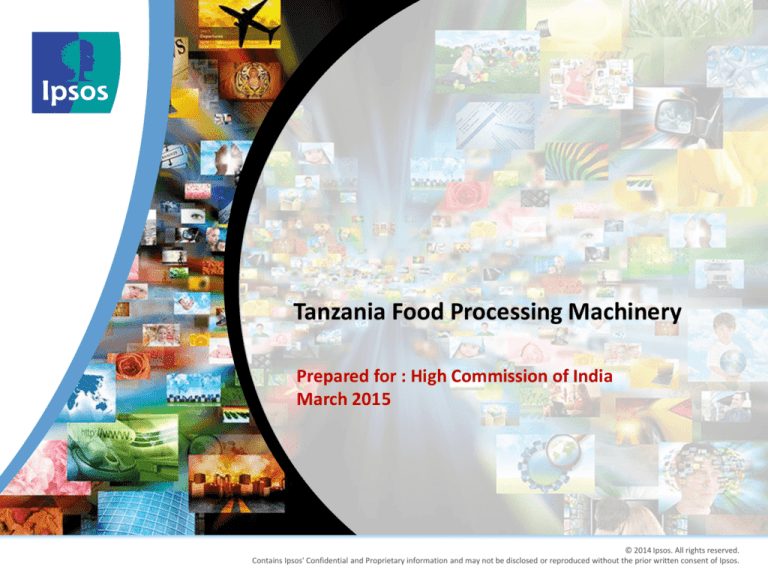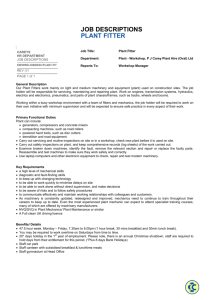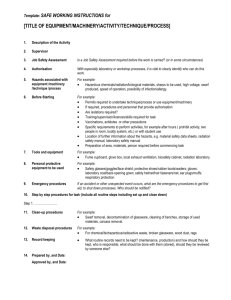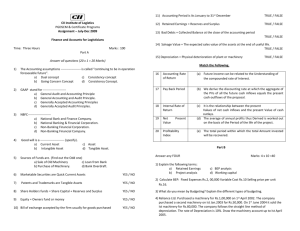
Tanzania Food Processing Machinery
Prepared for : High Commission of India
March 2015
© 2014 Ipsos. All rights reserved.
Contains Ipsos' Confidential and Proprietary information and may not be disclosed or reproduced without the prior written consent of Ipsos.
Background
BACKGROUND OF STUDY
The High Commission of India ‘s objective is to understand the food manufacturing sector of Tanzania so as to
enhance the importation of the machinery necessary for this industry. The machinery to be imported is for
fruit, vegetable and crops processing. The High Commission of India wants to understand the market
determining factors such as size of the marker, availability of machinery and source of supply
3
RESEARCH APPROACH AND SAMPLE
Desk research was
conducted through review
of major publications
regarding the industry
Qualitative: In-depth
interviews with major
stakeholders in the
industry
Methodology
Interviews were
conducted among :
Food processors
Ministry Officials
Importers of Machinery
Fieldwork was conducted
January- March 2014
A 2hr discussion guide was
used to collect primary
data collection
Fieldwork was done in Dar
only
Sample
Fieldwork
4
EXECUTIVE
SUMMARY
11%
Contribution of manufacturing to GDP
55%
Contribution of agro-processing to manufacturing
ECONOMY OVERVIEW
Production index of the manufacturing industry
Tanzania Imports Q4 2014
Million dollars
Commodity
Sep-2014
Oct-2014
Nov-2014
Food and Food
stuff
151.8
155.3
147.9
Machinery
291.0
341.9
475.3
2011
Source: Bank of Tanzania and Tanzania Revenue Authority (2014)
Annual Growth of Bank Credit to
Manufacturing
22.4%
19.1%
19.4%
2014 Jan
2014 Dec
2015 Jan
Source: Bank of Tanzania and Tanzania Revenue Authority (2015 )
2012
% change
Food, beverages
and tobacco
392
458
16.8
Paper and paper
products
343
360
5.0
Chemical,
petroleum, and
plastic products
140
129
7.9
Basic metals
industries
260
298
14.6
Source: National Bureau of Statistics (2012)
•
Market for processed Goods is growing stimulating an increase in
local production hence increase in demand for machinery
•
Borrowing for manufacturing in Tanzania is increasing, it is at the
top 3 of total borrowing after personal borrowing and borrowing for
trade. This is an indicator of expected increase in demand for
machinery
•
In the year 2012, the overall Production Index of Manufacturing
Industry was 328 compared to 296 for the year 2011, which is
10.8 percent increase. This increase was attributed to the
increase of production in the Following groups, food, beverages
and tobacco (16.8 percent) (National bureau of statistics)
7
CHARACTERISTICS OF THE FOOD PROCESSING INDUSTRY
The food processing sector is characterized by micro and small scale processors, with very few medium
and large size processors .
Concentration of processing firms is few regions with majority located in Dar es Salaam, Tanga,
Kilimanjaro and Arusha
The micro and small enterprise are defined as those with 5 to 59 employees or with a capital of 5 mil TZS
to 200 mil TZS
On average processors are willing to spend $,1,000 - $10,000 on Machinery
Among the micro and small fruit enterprise processors the average monthly income is at 357,743,000 TSH
where as the expenditure on machinery is 1,812,403 TSH ( Journal of applied economic and Business)
Increased urbanization and changing lifestyles show a promise for increased demand in processed foods in
Tanzania
8
PROCESSING MACHINERY WHITE SPACE
Through the implementation of the Integrated Industrial Development Strategy (IIDS), Tanzania targets the
manufacturing sector ( with emphasis to the agro- processing sub sector )to grow by 15 % per annum on
average, to attain a gross manufacturing value of 16 billion US Dollars and 23%share in GDP composition by
2025
The edible oil market in Tanzania
is estimated as being worth
around 200,000 ton per
annum
Through the spread of scientific
agriculture and contract farming
with oil processors, IIDS
supports the revival of the local
oil industry
•
•
Cashews are high value in
the international market but
70% of Tanzania Cashew
nuts are unprocessed
IIDS supports local
processing including
extension of institutional
and financial support to
processing firms
• A Large variety of fruits
• and vegetables are
produced in Tanzania
• Of the 2.75 million tons of
fruits and vegetables
produced annually only 4% is
processed
“The targeted sub-sectors specified in the IIDS 2015 are fertiliser and chemicals, iron and steel, textiles, agroprocessing, edible oil, processed cashew nuts, processed fruits, milk and milk products, leather and leather
products, light machinery and the hospitality industry”. - Abdallah Kigoda, Minister of Industry and trade
9
Food Processing
Machinery
PROCESSING MACHINERY LANDSCAPE
•
There are very few manufacturers in the country, major players
include Intermech, SIDO, PMF2000 and NANDWA .Most of the food
processing machinery is imported. The biggest known importer is
Poly Machinery. Other importers include donor funded programs
•
Machines are currently imported from China and to a small extent
Japan. The major driver for importing from China is the price of the
machinery. Where as India processing machineries are not commonly
used many tractors used in farming are from India
Industry
players
Machinery
Imports
Regulatory
Authorities
•
Germany and Italy are considered to have the best quality processors
especially in meat processing, the largest barrier to using imports from
these countries is price
•
Importation is largely done at an individual level. The available
importers do it on a need to basis
•
The type of machinery used in food processing is regulated and
approved by Tanzania Food and Drugs Authority( TFDA) and Tanzania
Bureau of Standards (TBS). The two authorities work hand in hand with
the ministry of agriculture to ensure that the machineries are of
required standards
“ I know about the
tractors from India such
as farm truck and Swaraj
brands but I have never
encountered the
processing machineries
from India” – Engineer
Ministry of Agriculture
“Intermech was
manufacturing a machine
for cassava chipping and
grating using the normal
steel sheets but TFDA
intervened and directed
them to use aluminum
materials to produce such
products” – Engineer
Ministry of Agricuture
11
MACHINERY USED
With the technology advancement processors are looking for combined machines (machines capable of
doing more than one function)
COMMON COMBINE MACHINERY
Rice combine harvesters
“With rice they use combined harvesters
which are useful in the manner that once
paddy is harvested by the machine it can
be processed right there on the firm to
get a completely finalized rice grain but
formerly it was that one small machine
will cut the paddy then it will be taken to
the chaffing machine to separate the
grains and later it will be taken to the
milling machine in order to get a
processed rice. - Engineer ministry of
agriculture
Meat cutting and grinding
“There is also an increase in the
purchases of the meat processing
machines which are currently
combined unlike the old machine
that forced us to go and cut the
meat on logs outside and bring it to
the machine for processing” – Meat
Processor
Cassava peeling and grinding
“The past they used to put the
cassava in a drum and left it to
ferment for a number of days that’s
when it can be grinded but now with
chipping it can be chipped in the
morning and grinded at the evening
to get the flour” – Engineer ministry
of agriculture
12
MACHINERY USED – FRUITS PROCESSING
Currently fruit processing is done in two major ways , juicing and pulping as well as drying.
In Tanzania during the rainy season there is an abundant supply of vegetables and there is scarcity of the
same in the dry season. To meet the demand during the entire year in all areas, the commodities have to be
preserved using different techniques. (http://www.fao.org/docrep/x5018e/x5018E0v.htm).
Common machinery/ equipment used for this includes swing solar drier and box solar drier. Majorly dried
commodities include but not limited to mango, pineapple, banana, rosale, ginger, cinnamon lemongrass,
dried and frozen cassava leaves, dried sweet potatoes leaves, pumpkin and tomato powder
For juices and pulping the common machinery used include, juice extractors, peeling and pulping
machines, packaging conveyer belts.
CASE:
Azam the largest food processing company in Tanzania which processes a wide range of locally grown fruits
and vegetables that include Mango, Pine Apple, Orange, Guava, Passion fruit, Tomato etc. For juice
production Azam gets its machinery support from Italian companies Fratelli Indelicate and FBR-ELPO .
FBR-ELPO manufactures machines for the production of tomato puree; tomato paste diced tomatoes
tomato pulp and peeled tomatoes as well as equipment for the production of pulpy juices, clear juices
and/or nectars, natural, semi concentrated and concentrated purees, diced fruit, treated also aseptically;
jams.
Fratelli Indelicate mainly provide the juice extractors and peeling and pulp machine
13
Machinery Purchase Drivers
•
The biggest driver in purchasing machinery is the price.
•
Consumers are also looking for durability of the machines, since machines are
imported and take time to reach the country durability becomes key
•
Technology is also a major driver to the machines bought. The more functions and
automation the better. Processors are keen to reduce labor costs
•
Output/ efficiency is also another driver to machinery selection
•
Country of origin is not a major concern for the processors, they would buy from
any country as long as the above criteria is met
“These machines are very expensive, with such an investment the machines need to be
durable” –Meat processor
14
Challenges with machinery in food processing
Machinery are not readily
available in workshops.
Workshops order machinery
upon demand from the
processor
Food processors find it
difficult to establish contacts
and correspond with suppliers
abroad, they need agents to
assist with the importation of
machinery
Spare parts are not readily
available. For machinery
uptake spare parts need to be
available
Maintenance services for
processing equipment are very
poorly developed. As a result
processors need machinery
that require minimum
maintenance
Machinery is capital incentive,
given that the processors are
small , they set aside and
average of at $1000 -$
“I would like it if there was a local
Tanzanian agent who will import
the machineries and stock them in
order to sell to us .I think it will
save us a lot of money and also
reduces the inconveniences which
we face” –flour mill owner
15
EDIBLE OIL- CASE STUDY
Flow of information of new equipment
Level of equipment change
64.9%
47.5%
33.8%
18.5%
21.6%
5%
2.7%
Media
Competitors
Suppliers
SIDO
3%
Technological
centers
Source: STRIPO (2012)
Using equipment
as bought
Improved
equipment
Introduced
different tpe of
equipment
Source: STRIPO (2012)
Constraints to using machinery
67%
Information on machinery is not readily
available any supplier/ importer would need to
ensure awareness is created
21.6%
2.7%
low linkages to
Suppliers
11.5%
Low linkages to Little awareness
technological
of new
centers
equipment
Once machinery is bought very few processors
tend to improve on them until after 3 or more
years.
High cost of
machinery
Cost is without a doubt the biggest hindrance to
machinery usage. Affordability is key for
machinery uptake
Source: STRIPO (2012)
16
Recommendations
RECOMMENDATIONS
• The government is currently pushing the fruit, cashew, edible oils and milk
processing . These are the areas importers of food processing machinery
should concentrate on as processing is expected to grow
• It is recommended that the imported machinery be one that is affordable and
one that is multifunction
• Avenues such as the Nanenane tradeshow are essential for creating
awareness. Currently there are few advertisements on processing machinery
as importers do not stock machinery. Media would be useful in creating
awareness
18
Thank You





